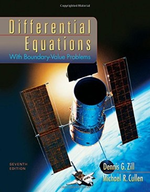Chemical Reactions When certain kinds of chemicals are combined, the rate at which the
Chapter 2, Problem 42(choose chapter or problem)
Chemical Reactions When certain kinds of chemicals are combined, the rate at which the new compound is formed is modeled by the autonomous differential equation where k 0 is a constant of proportionality and 0. Here X(t) denotes the number of grams of the new compound formed in time t. (a) Use a phase portrait of the differential equation to predict the behavior of X(t) as t : . (b) Consider the case when . Use a phase portrait of the differential equation to predict the behavior of X(t) as t : when X(0) . When X(0) . (c) Verify that an explicit solution of the DE in the case when k 1 and is X(t) 1(t c). Find a solution that satisfies X(0) 2. Then find a solution that satisfies X(0) 2. Graph these two solutions. Does the behavior of the solutions as t : agree with your answers to part (b)?
Unfortunately, we don't have that question answered yet. But you can get it answered in just 5 hours by Logging in or Becoming a subscriber.
Becoming a subscriber
Or look for another answer
